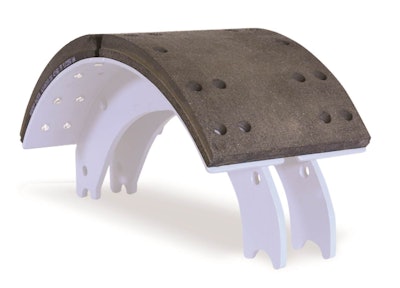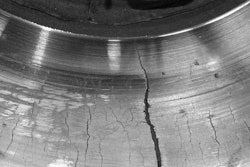
“In commercial vehicle drum brake applications, temperature’s critical role begins at the engagement point between the lining and the drum,” says Earl Brown, product manager, reman brake shoes at Bendix. “The bulk drum temperature generally ranges between 600° and 650°F, although for brief times during engagement – and during Federal Motor Vehicle Safety Standards (FMVSS) testing – it is not uncommon for this temperature to exceed 1,000°F. These two measurement points – engagement and bulk drum temperature – represent the full temperature range experienced by all friction materials in drum brake applications.”
Specifics like these, Brown says, are the keys to understanding the temperature ratings of friction materials for severe-duty applications.
“When discussing friction temperature, it’s critical to establish a point of reference,” he says. “Since the brake system has a wide variety of components – each with unique thermal properties – it’s impossible to identify one temperature as most critical to the system as a whole.”
In a drum brake, the system’s temperature begins at the engagement point, where temperatures can go above 1,000°F. This heat dissipates as it is transferred into the heat sink – in this case, the drum. Without that heat dissipation, Bendix says the cast-iron drum would be red hot, creating an extreme environment difficult for any type of friction material to withstand.
With repeated stops and this heat transfer into the drum, Bendix says the overall temperature of both the drum and lining will slowly rise as they become heat soaked. In the case of normal commercial vehicle use with adequate cooling air, average temperatures may reach around 200° to 300°F on the lining and 300° to 500°F on the drum. These temperatures are within the acceptable range for their components’ respective materials, Bendix says such as cast iron and phenolic resins – the key binding agents used in non-asbestos organic (NAO) friction materials.
Under some conditions, such as severe-duty use, applications requiring more frequent or harder stops, or situations in which cooling air to the brake is restricted, braking temperatures can increase.
“Phenolic resins begin to degrade at temperatures ranging from 248° to 482°F,” Brown says. “In severe-duty applications, higher grade resins are used to better withstand this heat, but regardless of the brand of friction, bulk friction temperatures should never exceed 300° to 400°F. Basic chemistry and physics mean that even the best resins only survive to 600°F.”
Because heat-induced degradation of the phenolic resins will increase lining wear, it can lead to the loss of stopping power in drum brakes known as brake fade. For this reason, the goal of brake and friction design is to maintain the lowest braking temperature possible, the company says.
Bendix says it’s important to remember, though, that the elevated temperatures at the engagement point of the friction and drum dissipate almost immediately. Although it may be acceptable to measure 1,000°F on the drum surface during engagement, prolonged exposure at this temperature will lead to the failure of any NAO friction.
The importance of keeping brake temperatures low, however, can lead to a misplaced reliance on brake lining temperature ratings, particularly those that claim ratings of 950° to 1,000°F.
The most important and accepted industry tests in the OE and aftermarket friction certification process are the FMVSS 121 and Society of Automotive Engineers (SAE) J2115 tests, used by Bendix and other leading brake and friction suppliers.
These two tests, which Bendix says all commercial vehicle drum brake friction materials must adhere to, establish the following bulk drum temperature guidelines:
- FMVSS 121 Dynamometer Test – Brake Power or Fade Section: 150° to 450°F
- SAE J2115 (Section 7 – Wear and Effectiveness at Temperature) – Measured at 250°, 350°, 450°, 550°, and 650°F
The crucial point to note is that neither of these tests references or makes a recommendation on “temperature ratings” for brake friction, the company says. Similarly, friction material certification guidelines from major truck manufacturers also do not include temperature ratings. This is because without specific information on what temperature is being measured – bulk drum or engagement – and where the readings are being taken, friction temperature ratings are merely numbers without context, Bendix says. Actual friction life and performance will be dictated by resin quality and performance in the SAE temperature wear section.
When considering friction for severe-duty applications, Bendix says advises customers to request the results of both the FMVSS 121 and SAE J2115 tests from any potential supplier. Regarding specific temperature claims, the company says to ask whether a supplier is measuring bulk drum or engagement heat, and where it’s being measured.
“Selecting the proper friction – particularly in severe-duty applications – is vital for maintaining the performance, service life, and safe operation of drum brakes,” Brown says. “Being familiar with the science and reasons behind friction design and recommendations, as well as proven industry standards, will go a long way toward making the right choices to meet your needs and keep your vehicles on the road and operating safely.”











